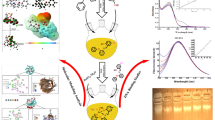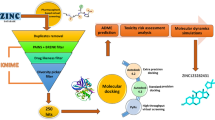Abstract
The tetrapeptides Ac-SKHM-NH2, Ac-TKHM-NH2, Ac-MKHS-NH2, Ac-S(OMe)KHM-NH2, and Ac-MKHS(OMe)-NH2 and the nonapeptides Ac-KTNSKHMAG-NH2 and Ac-KTNMKHSAG-NH2 were synthesized and their copper(II) complexes were studied by potentiometric, UV–Vis, circular dichroism (CD), and electron paramagnetic resonance (EPR) spectroscopic methods. These peptides mimic the 109–112 and 106–114 residues of the sequence of human prion protein. The imidazole-N donor atoms of histidyl residues were found to be the primary metal binding sites of all peptide fragments. This binding mode provides a good possibility for the cooperative deprotonation and metal ion coordination of two amide functions preceding histidine. The (Nim,N−,N−)-bonded species predominate in the pH range 5.5–7.0 and the free coordination sites of these species make possible the metal binding of weakly coordinating side chains. The comparison of the potentiometric and spectroscopic results revealed the stabilizing role of the oxygen donors of seryl, threonyl, or methoxyseryl residues of Ac-SKHM-NH2, Ac-TKHM-NH2, Ac-S(OMe)KHM-NH2, and Ac-KTNSKHMAG-NH2 containing the mutations in position 109. These interactions were, however, not observed in the peptides containing the specific amino acids in other locations of the peptide sequence.
Graphical abstract






Similar content being viewed by others
References
Sigel H, Martin RB (1982) Chem Rev 82:385
Sóvágó I (1990) In: Burger K (ed) Biocoordination chemistry, metal complexes of peptides and derivatives. Ellis Horwood, Chichester, p 135
Kozlowski H, Bal W, Dyba M, Kowalik-Jankowska T (1999) Coord Chem Rev 184:319
Sóvágó I, Ősz K (2006) Dalton Trans 3841
Brown DR, Kozlowski H (2004) Dalton Trans 1907
Millhauser GL (2004) Acc Chem Res 37:79
Jószai V, Nagy Z, Ősz K, Sanna D, Di Natale G, La Mendola D, Pappalardo G, Rizzarelli E, Sóvágó I (2006) J Inorg Biochem 100:1399
Di Natale G, Grasso G, Impellizzeri G, La Mendola D, Micera G, Mihala N, Nagy Z, Ősz K, Pappalardo G, Rigó V, Rizzarelli E, Sanna D, Sóvágó I (2005) Inorg Chem 44:7214
Grasso D, Grasso G, Guantieri V, Impellizzeri G, La Rosa C, Milardi D, Micera G, Ősz K, Pappalardo G, Rizzarelli E, Sanna D, Sóvágó I (2006) Chem Eur J 12:537
Ősz K, Nagy Z, Pappalardo G, Di Natale G, Sanna D, Micera G, Rizzarelli E, Sóvágó I (2007) Chem Eur J 13:7129
Di Natale G, Ősz K, Nagy Z, Sanna D, Micera G, Pappalardo G, Sóvágó I, Rizzerelli E (2009) Inorg Chem 48:4239
Hahn M, Wolters D, Sheldrick WS, Hulsbergen FB, Reedijk J (1999) J Biol Inorg Chem 4:412
Bóka B, Nagy Z, Várnagy K, Sóvágó I (2001) J Inorg Biochem 83:77
Várnagy K, Bóka B, Sóvágó I, Sanna D, Marras P, Micera G (1998) Inorg Chim Acta 275–276:440
Pettit LD, Robbins RA (1995) In: Berthon G (ed) Metal-peptide complex formation, in handbook of metal–ligand interactions in biological fluids, vol 1. Marcel Dekker, New York, p 636
Gergely A, Farkas E (1982) J Chem Soc Dalton Trans 381
Bühl M (2000) J Inorg Biochem 80:137
Farkas E, Kiss T (1989) Polyhedron 8:2463
Szabó-Plánka T, Árkosi Z, Rockenbauer A, Korecz L (2001) Polyhedron 20:995
Kowalik-Jankowska T, Stasiak M, Leplawy MT, Kozlowski H (1997) J Inorg Biochem 66:193
Mlynarz P, Gaggelli N, Panek J, Stasiak M, Valensin G, Kowalik-Jankowska T, Leplawy ML, Latajka Z, Kozlowski H (2000) J Chem Soc Dalton Trans 1033
Mlynarz P, Kowalik-Jankowska T, Stasiak M, Leplawy ML, Kozlowski H (1999) J Chem Soc Dalton Trans 3673
Mlynarz P, Bal W, Kowalik-Jankowska T, Stasiak M, Leplawy ML, Kozlowski H (1999) J Chem Soc Dalton Trans 109
Kállay C, Várnagy K, Malandrinos G, Hadjiliadis N, Sanna D, Sóvágó I (2006) Dalton Trans 4545
Nishida Y, Hayashida K, Kida S (1980) J Coord Chem 10:101
Irving H, Miles G, Pettit LD (1967) Anal Chim Acta 38:475
Zékány L, Nagypál I (1985) In: Leggett D (ed) Computational methods for the determination of formation constants. Plenum, New York, p 291
Gans P, Sabatini A, Vacca A (1985) J Chem Soc Dalton Trans 1195
Acknowledgments
This work was supported by the MTA(Hungary)-CNR(Italy) bilateral program and the research grant OTKA-NKTH 77586, OTKA 72956 and PD 72321 and TAMOP 4.2.1/B-09/1/KONV-2010-0007 (Hungary).
Author information
Authors and Affiliations
Corresponding author
Rights and permissions
About this article
Cite this article
Kállay, C., Turi, I., Timári, S. et al. The effect of point mutations on copper(II) complexes with peptide fragments encompassing the 106–114 region of human prion protein. Monatsh Chem 142, 411–419 (2011). https://doi.org/10.1007/s00706-010-0413-2
Received:
Accepted:
Published:
Issue Date:
DOI: https://doi.org/10.1007/s00706-010-0413-2




